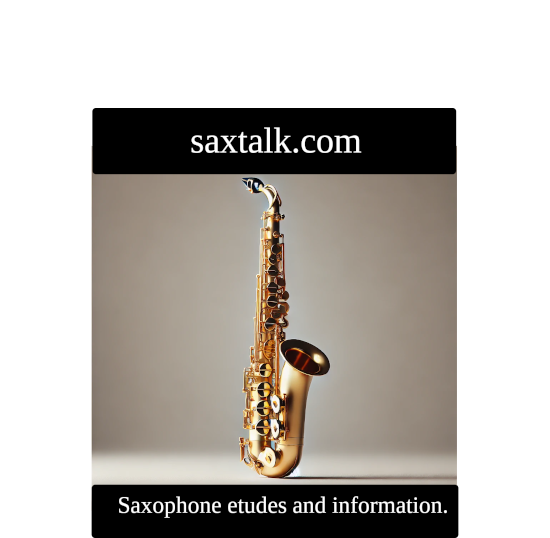Using the Andalusian Cadence to Build Jazz Improvisation Skills
Introduction
The subconscious mind retains a lot more information than the conscious mind does. When you fill your subconscious mind with a lot of musical information, that information slowly seeps into your conscious mind, and it improves your playing. Over this next series of articles, I'm going to explore many musical styles that the jazz saxophonist can study to improve his or her playing. In this first article in the series, I'm going to look at the Andalusian Cadence.
What is the Andalusian Cadence?
The Andalusian Cadence is a specific musical phrase or progression, primarily associated with flamenco music from Andalusia, a region in southern Spain. It's also known as "El Tremolo" due to its characteristic tremolo effect on the guitar or other instruments used in flamenco.
The traditional Andalusian Cadence consists of the following chord progression: Am - D7 - G - F, repeated over and over again. This pattern is often played with a specific rhythm and emotion that reflects the passion and intensity characteristic of flamenco music.
However, it's important to note that the Andalusian Cadence is more about the rhythmic structure, feel, and emotional expression than strictly adhering to a particular chord progression. It's a fundamental element in flamenco music, but it can be interpreted and adjusted by artists according to their style and personal creativity.
In addition to its role in flamenco, the Andalusian Cadence has also been used in other musical genres, such as jazz and pop, demonstrating its versatility and enduring influence on music worldwide.
Learning the Andalusian Cadence in All 12 Keys to Improve a Saxophonist's Improvisation Capabilities
To enhance a saxophonist's improvisational skills, mastering the Andalusian Cadence in all 12 keys is an excellent approach. First, it's essential to understand the traditional Andalusian Cadence chord progression, Am - D7 - G - F, and its rhythmic structure. Once familiar with this foundational progression, the next step is to transpose it into each of the 12 keys. This involves identifying the corresponding chords in each key, such as Cm - G7 - D - Am in the key of C Major, and maintaining a chart to track your progress.
Practicing the cadence is equally important, as it allows you to experiment with different rhythms, dynamics, and articulations. This exploration helps you to develop a personal interpretation of the cadence while expanding your expressive range. As you become comfortable with the progression, you can begin improvising over each transposed version of the cadence. Start with simple melodies that follow the chord changes and gradually incorporate more complex elements, such as chromatic passages, blue notes, or syncopation.
Additionally, combining the Andalusian Cadence with other musical elements, such as scales, arpeggios, or chord progressions, can further enhance your improvisational toolkit. Listening to flamenco musicians who utilize the Andalusian Cadence can provide valuable inspiration and insight into the various ways this cadence can be interpreted and manipulated. Finally, consistent practice is crucial. Regularly incorporating the Andalusian Cadence into daily warm-ups and improvisational exercises will help solidify your understanding and application of this essential musical structure, ultimately improving your overall improvisational capabilities on the saxophone.
Are there any scales that are useful to learn for improvising over the Andalusian Cadence, particularly in a jazz setting?
Yes, when improvising over the Andalusian Cadence, especially in a jazz setting, several scales can be particularly useful. Here are some suggestions:
- The harmonic minor scale: This scale is closely related to the natural minor scale (Aeolian mode) but contains a raised seventh degree that creates tension and resolution, fitting well with the cadence's emotional intensity. In the key of C Major, the harmonic minor scale would be C - D - Eb - F - G - Ab - B - C.
- The Melodic Minor scale: Similar to the harmonic minor scale, but the sixth degree is raised only when ascending and left natural when descending. This creates a smoother transition between the chords in the cadence. For example, in the key of C Major, the ascending melodic minor scale would be C - D - Eb - F - G - A - B - C, while the descending scale would be C - D - Eb - F - G - Ab - Bb - C.
- The Altered Scale, also known as the Super Locrian scale, is a musical scale used in jazz improvisation, particularly over dominant seventh chords to create tension. It is constructed by lowering the fourth, fifth, and seventh degrees of the corresponding dominant scale. For example, in the key of C Major, the altered scale for a G7 chord would be G - Ab - Bb - Db - Eb - F - G.
- The Chromatic Scale: This scale includes all 12 notes within an octave and can be useful when improvising passing tones or creating dissonant effects that contrast with the cadence's rhythmic drive.
- The Whole-Half Diminished scale: This scale is often used over half-diminished chords (minor seven flat five) in jazz music and can be a great tool for improvising over the dominant seventh chord (D7) in the cadence progression. In the key of C Major, the whole-half diminished scale for D7 would be D - E - F - G - Ab - Bb - B - C# - D.
By incorporating these scales into your improvisational vocabulary, you'll expand your musical palette and find new ways to approach the Andalusian Cadence in a jazz setting.
